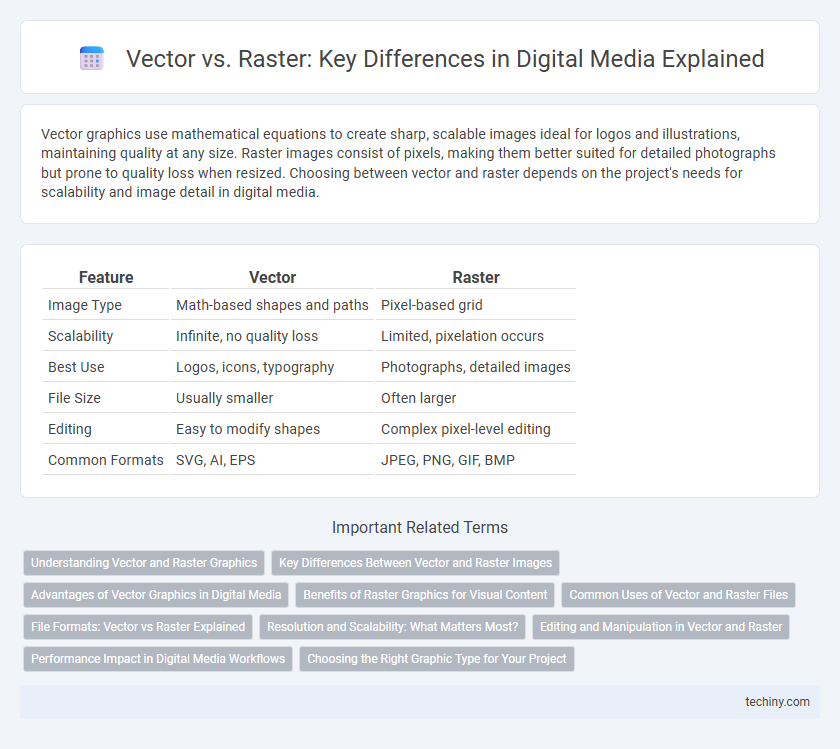Vector graphics use mathematical equations to create sharp, scalable images ideal for logos and illustrations, maintaining quality at any size. Raster images consist of pixels, making them better suited for detailed photographs but prone to quality loss when resized. Choosing between vector and raster depends on the project's needs for scalability and image detail in digital media.
Table of Comparison
| Feature | Vector | Raster |
|---|---|---|
| Image Type | Math-based shapes and paths | Pixel-based grid |
| Scalability | Infinite, no quality loss | Limited, pixelation occurs |
| Best Use | Logos, icons, typography | Photographs, detailed images |
| File Size | Usually smaller | Often larger |
| Editing | Easy to modify shapes | Complex pixel-level editing |
| Common Formats | SVG, AI, EPS | JPEG, PNG, GIF, BMP |
Understanding Vector and Raster Graphics
Vector graphics use mathematical equations to create scalable images without loss of quality, making them ideal for logos and illustrations. Raster graphics consist of pixels arranged in a grid, best suited for detailed and complex images like photographs but lose clarity when resized. Choosing between vector and raster depends on the need for scalability versus detail in digital media projects.
Key Differences Between Vector and Raster Images
Vector images use mathematical equations to create crisp, scalable graphics that maintain quality at any size, making them ideal for logos and illustrations. Raster images consist of pixels arranged in a grid, which can lose clarity and appear pixelated when enlarged, thus their quality depends on resolution. The primary difference lies in scalability and file size, with vector files typically being smaller and resolution-independent compared to resolution-dependent raster files.
Advantages of Vector Graphics in Digital Media
Vector graphics offer superior scalability, ensuring crisp and clear images at any size without loss of quality, which is crucial for responsive digital media designs. Their smaller file sizes improve loading times and overall website performance, enhancing user experience across devices. Additionally, vector files allow for easy editing and customization, streamlining workflow for designers and enabling efficient adaptation to various digital formats.
Benefits of Raster Graphics for Visual Content
Raster graphics deliver exceptional color depth and detail, making them ideal for rich photographic images and complex textures. Their pixel-based structure supports smooth gradients and subtle tonal variations crucial for lifelike visual content. Compatibility with most editing software and widespread digital platforms enhances their versatility in digital media production.
Common Uses of Vector and Raster Files
Vector files are commonly used in logo design, typography, and illustrations due to their scalability without loss of quality, making them ideal for branding materials and print media. Raster files dominate in digital photography, web graphics, and detailed image editing where pixel-based data provides rich color depth and texture. Both file types serve distinct purposes in digital media workflows, with vectors excelling in precision graphics and rasters in complex, color-rich images.
File Formats: Vector vs Raster Explained
Vector file formats such as SVG, AI, and EPS use mathematical equations to create scalable graphics ideal for logos and illustrations without loss of quality. Raster file formats like JPEG, PNG, and GIF consist of pixel grids, making them suitable for detailed images like photographs but prone to pixelation when resized. Choosing the correct format depends on the need for scalability and image complexity in digital media projects.
Resolution and Scalability: What Matters Most?
Vector graphics maintain crisp quality at any resolution due to their scalable mathematical formulas, making them ideal for logos and digital interfaces where clarity at various sizes is essential. Raster images rely on fixed pixel grids, leading to quality loss and pixelation when enlarged, which limits their scalability and effectiveness in high-resolution applications. Choosing between vector and raster formats depends on the need for resolution independence and scalability in digital media projects.
Editing and Manipulation in Vector and Raster
Vector images allow precise editing and manipulation of individual shapes using anchor points and paths, ensuring scalability without quality loss. Raster images consist of pixels, making detailed photo editing and color adjustments possible but often leading to quality degradation when resized. Vector graphics are ideal for logos and illustrations, while raster is preferred for complex images like photographs.
Performance Impact in Digital Media Workflows
Vector graphics offer superior performance in digital media workflows due to their scalability and smaller file sizes, enabling faster rendering and reduced memory usage compared to raster images. Raster graphics, consisting of pixels, demand more processing power and storage, especially at higher resolutions, which can slow down media editing and playback processes. Optimizing workflow efficiency requires balancing vector's lightweight nature with raster's detailed image capability, particularly in animation and high-resolution media production.
Choosing the Right Graphic Type for Your Project
Selecting between vector and raster graphics hinges on the project's purpose and output medium. Vector images, composed of mathematically defined paths, excel in scalability and are ideal for logos, icons, and print designs requiring crisp lines at any size. Raster graphics, built from pixel grids, offer superior detail and color depth, making them suitable for complex images such as photographs and digital artwork intended for web and screen display.
Vector vs Raster Infographic

 techiny.com
techiny.com